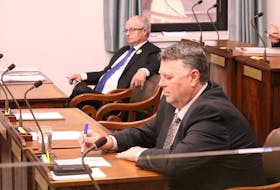BY WENDY ELLIOTT
Kings County Advertiser/Register
What happens to people when they die is a mystery, says Kentville’s palliative care specialist Dr. Catherine McNally, but the way in which the terminally ill are eased into death begins with a society that cares.
With that thought in mind, consider the following timeline for the hospice dream in the Annapolis Valley. It begins almost 20 years ago.
In 1993, after conversations between VON nurses and Dr. Jeanette Auger, who taught the sociology of grief at Acadia University, the first formal study of a possible Valley hospice began. Issued in 1997, the study was entitled Mind, Body and Soul: Exploring the Need for a Hospice in Kings County.
A 13-member hospice foundation board was created in 2000. In 2001, another study was released, “Completing the Continuum.”
In 2002, board member Canon Sid Davies toured hospices in Australia and England. He learned, “practically every community of any size has at least one hospice.” We surely should be thinking about a hospice for our community, he told me.
Ever optimistic, in 2003 this newspaper ran an editorial headlined “Opportunity to Back Hospice is at Hand.” Federal funds pinpointed by the Romanow Report were thought to be available shortly.
Shortly afterward, then-provincial health minister Jane Purves wrote, “we recognize there is a need for improved palliative care service in Annapolis Valley health. The evidence shows there is a need, the people of your district expect this service, and the health professionals and volunteers of the district have shown an unparalleled commitment to delivering it.”
May 5, 2004, then-Liberal health critic Dave Wilson asked in the Legislature about the “long-proposed hospice in the Annapolis Valley.” Two hospice board members, Alex Colville and Dr. Jim Perkin, were in Province House to hear the issue raised. At the time, our renowned artist said of the Hamm government, “they are all stalling as if they’d never heard of a hospice… in this case, the government is failing the people.”
Retired physician Arthur Grebneff of Wolfville told a hospice foundation AGM that spring a key problem is palliative care is not a sexy topic.
In June 2004, Liberal candidate Scott Brison said he was committed to lobby both Ottawa and Halifax in order to establish a hospice in Kings County.
In 2005, the Annapolis Valley Hospice Foundation and Annapolis Valley Health came together to explore their common visions. By 2007, the two foundations had formed the Partnership for Better Health, the largest capital initiative undertaken since the hospital foundation built Valley Regional. AVH Foundation chairwoman Trinda Ernst and hospice foundation chairwoman Diana Patterson said they needed $8 million to meet the objectives of the campaign, although they had yet to publicly launch it and costs would likely increase.
In May 2007, former hospice chairman Dr. Jim Perkin said, “we are very pleased that after many years of research and consultation, we have reached this point.”
And, “the average life expectancy and the average age in the Annapolis Valley is higher than national and provincial averages, meaning that there is a greater need for health services such as end-of-life care than in other parts of the province and country,” AVH palliative care manager Shelagh Campbell-Palmer stated.
In 2008, the Rotary Clubs of Kentville, Middleton, New Minas and Wolfville launched the Annapolis Valley Rotary Giving Campaign and the hospice cause was part of that exercise.
In January 2009, the campaign was termed active. Funds to build the first stand-alone hospice in Nova Scotia, renovate the 16-year-old Kentville hospital, open the number of beds originally intended, purchase and renovate AVH offices on Chipman Dr., and add capital equipment would total $16 million, but the province was expected to kick in just over half.
By April 2010, some of the hospital redevelopment had occurred but, obviously, a hospice and palliative care centre that had to be 100 per cent community built was a hold up. Once built, Annapolis Valley Health will staff, operate and maintain the hospice.
Nurse manager Kathy Swindells said palliative patients are in the medical unit now, in regular beds. Staff do their best to provide quality care, but Swindells said the hospice will have a more home-like setting, supporting medical patients across the district.
Today, the Our Community, Our Health campaign stands at about $5.2 million of the $8 million goal. The foundations are asking Valley residents to celebrate birthdays or special occasions by asking friends and family to make donations to Our Community Our Health instead. Gifts of this kind could
have a huge impact on the campaign – as much as half-a-million, organizers believe.
This time line is way too long, so I will close this litany by repeating Dr. McNally’s words: the way in which the terminally ill are eased into death begins with a society that cares.








